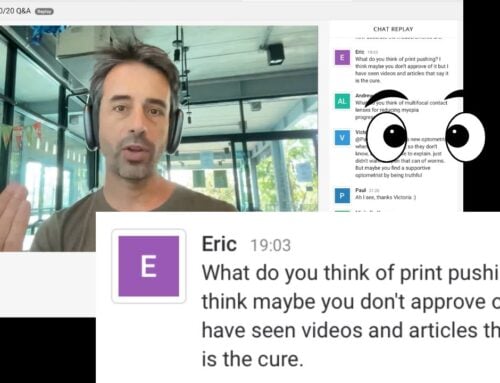Have you ever heard me say … the forum is gold?
Yes Jake, you say. You’re saying it all the time.
But unless you’re one of the big ballers in the very shiny, very exclusive BackTo20/20 club (from where Jake get all the yacht-fuel monies), you don’t get to see most of it. Or you wouldn’t if I didn’t magnanimously frequently post some of the highlights here, in the common-people blog.
Joking. Love for everyone, (almost) equally!
Here’s the deal, though. You might run into double vision issues, and we can totally prevent this from making your progress all complicated.
Bradley writes:
I’ve been using the EndMyopia Method (hello Jake!) since summer 2013 and have gone all over the map from wearing glasses for nine years as a child to the Bates Method no-glasses nightmare for 1 year, to a low -1.25 (OD/OS) today which I only wear at night or when driving. Basically, that’s almost a 75% reduction in 3 years from -3.75/-4 (OD/OS) to -1.25.
Even the cold, hard CM measurements point to major improvement:
2013-2014
OS: 59 OD: 742015
OS: 67 OD:852016 (so far)
OS: 71 OD: 89So, on paper, my eyes have gotten better–and I have noticed many subtle changes–but in reality, I feel stuck in exactly the same place as my last forum post, mainly because of this inability to shake double vision once and for all.
I get it in each eye separately (almost like astigmatism) at almost any distance beyond 50cm, and although it never fully fuses, it gets much easier to resolve by changing the distance.
Based off of all the content here on EndMyopia and my personal experience, my thoughts are that this is more of a brain issue than an eye issue, perhaps something to do with excessive stress on the visual cortex or the brain accepting blur/strain as normal?
I’d appreciate ANY advice, suggestions, or insights, because this vision problem has been extremely debilitating and made my day-to-day life just plain uncomfortable.
Since I wrote a rather long answer to this one, which generally applies to most on this journey, I’d like to make it useful for everybody who ends up on this path.
Here’s my explanation:
Based on your background (very helpful, that), and your current experience, here’s a bit of background:
You experienced a lot of change in ciliary control, possibly axial reduction. Your eyes are designed to adapt to the “correct” focal plane, and are actually amazingly flexible in this regard (from early childhood your eyes developed from environmental feedback, adjusting in shape and length). And while one can argue that this flexibility wasn’t biologically meant to work to recover from false focal planes, we do know that it does work.
On the flip side, there’s your visual cortex. It’s *not* expecting focal plane changes. The biological expectation there is for your eye to adjust by environmental stimulus, and your visual cortex “just” interprets the optimized signal.
The eyes are supposed to dial *in* towards the optimal focal plane. Because of what we’re doing to reverse the false focal plane stimulus, we’re making the system work backwards, in some respects. Now you creating stimulus using the crutch of lenses for focal plane changes. We’re dragging the eyes back to the correct focal plane, and all the change in visual signal now needs to be “re-aligned” by your visual cortex.
There’s a lot of conjecture in the rest of this (considering the cutting edge of this entire approach). Some say that axial elongation, what happens naturally in early childhood, adapts faster and easier than axial reduction. Some say that your visual cortex becomes less flexible with age. Some say that our method of forcing change with stimulus from lenses is too crude of an approach, with the 1/4 diopter (relatively large gap) changes, and sorting out prescription complexity and astigmatism at the same time.
Nobody can say for certain.
But either way, the 75% change is more than you can expect your visual cortex to necessarily adapt to in a short period of time. I’ve seen it many times where the eyes change much more quickly than your brain will tolerate. That’s part of the reason I quantify your progression as blur > double vision > clear, to make sure that you don’t reduce before both the eyes and the visual cortex have fully adapted to the changed focal plane and stimulus.
Recognize that this is a vital part of the process. If you have to go back up a quarter diopter (or more), to where the double vision is manageable and fuses, it’s not a step backwards. You’re just catching up on what you skipped earlier. Giving the biology time to adapt (and for you to enjoy your gains) is an important part of the process.
TL;DR: Take it easy for a while. You know that focal planes are something you can leverage for improvement. Don’t get too hung up on the number, instead focus on your visual experience. Make slow changes (don’t go up or change lens use for a day or three and make judgments based on that). You already proved to yourself that you can do it, now sit back and enjoy the process, don’t rush it. Maybe you wear the -1.25 during the day for a month or two, and realize you no longer need them. Go with a bit of the flow.
P.S.: I’ve been through a lot of this, too. As have lots of others. Perfectly normal to push it, and totally reasonable to get some outside perspective, and go … ok, I can chill out on this for a minute.
Make sense?
I’ll tell you a little secret. More often than you want to imagine, breakthroughs in science (and discoveries about the human body) are made first by accident, inadvertently, or by simple experimentation. And then when faced with new insights, the science, the “why”, the explanation, is a bit reverse engineered to fit the findings.
I know, it’s terrible and you’re not supposed to make this admission.
Remember the crazy, sketchy stem cell treatment for blindness? That guy is my personal hero. And that’s just one of many thousands of these exact kind of incidences. We get a surprising result, and then later we try to explain it.
Above, what I tell Bradley, is exactly some of this. Granted, the explanation is based on quite a bit of research, looking at results that confirm known parts of the equation. But since I’m not trying to win a Nobel prize or get a statue in the park, I’ll just tell you how it is. There could be little elves in there, spinning little elven wheels.
All I can tell you for sure is that you need to follow blur > double vision > clear > lower prescription in your progression of lens reductions, and not simply go blur > double vision > lower prescription.
You do the latter, and you accumulate debt with your visual cortex, that you’ll have to pay eventually.
Bonus post:

I won’t post my comments on this one here, you can find them in the forum post.
Point of the bonus post, remember your peripheral vision. It’s the details, seemingly, that make it all worth it. Use the search function here to find more posts on peripheral vision, if you’re curious.
And bonus, bonus post (from Facebook), with some hard hitting truth:

In the end, that’s the fingers to point. It’s not the optometrist, they’re just the McDonald’s franchisee, selling people what they want. There’s demand, there will be supply. Nobody wants to hear, step away from your Xbox, close that Youtube tab.
Housekeeping: If you’re a regular reader, you probably are part of a very, *very* small niche of humanity.
You are open minded, and yet ambitious enough to dig through some boring science to find actual likely truths. You’re not gullible enough to buy all the fruity hippie Internet nonsense (the category that most open minded people seem to fall into). You care more about your long term health and well-being, than instant gratification. You’re not like an overgrown small child, like much of today’s world.
You’re part of a truly tiny niche indeed.
There’s that. Add the fact that @endmyopia is in no small part a thought experiment (breaking the mainstream paradigm of myopia truths and treatment, via the Internet). In the spirit of all this, the whole “value trading” part of the experience (ie. paying for BackTo20/20) might soon become a bit more … adventurous as well.
You probably know my struggle, balancing the fun of creating this resource, with the headaches of managing it. One of those pieces, behind the scenes, is … money. It’s technically not really “worth it”, economically speaking, for me to run this site for money. But I like it for the principle of trading value, and as a token of real commitment from participants.
But it’s such a pain to deal with, that I’ve been thinking hard of how else to maintain the benefits of money, without having to deal in actual money. And limit dealing with nosey banks, troublesome payment processors, the herd of disagreeable accountants, and everything else (a luxury, since my actual “income” is from elsewhere, not this project here).
Long story short, we might experiment with cryptocurrencies, ie. Bitcoin stuff, soon. Meaning that payment options here may soon become less mainstream, and a bit more adventurous for those who want into BackTo20/20. That may mean less participant demand, and even more specifically the motivated and interesting individuals for us all to connect with in the future.
If I can figure out how to work the Bitcoin thing, I may make future applicants for out little group do it as well. Stay tuned. (none of this affects existing participants, no worries!)
And if you’re just a blog reader, then, all is as ever, carry on. ;)
Cheers,
-Jake



















